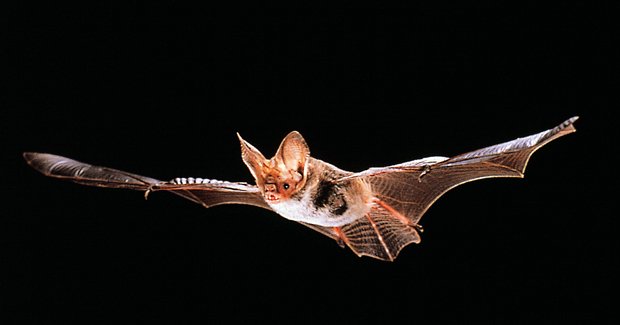Encyclopaedia of bat language created

A FORMAL DICTIONARY OF bat sounds is nearing completion in Western Australia, enabling scientists to identify echo-locating bats without having to catch or handle them.
Thousands of individual calls have been recorded from all 35 species of echo-locating (microbats and small insect-eating) bats in WA, along with observations on their flight and foraging habits. There are 64 known species of echo-locating bats in Australia.
Each microbat species tends to use different frequencies to help it hunt in flight. “We’re trying to avoid the situation where you have to catch or shoot these creatures to learn about and identify them,” says zoologist Norm McKenzie, from the WA Department of Environment and Conservation.
Norm and his colleagues have built up the dictionary by catching bats, putting bioluminescent markers on them and then recording individuals as they fly around at night after release, he says.
Non-invasive tool
Fruit bats have large eyes and superb vision, which they rely on on entirely to find their way around at night. Microbats, on the other hand, need a combination of sight and sound (sonar) to navigate and hunt for food.
“We think they overlay the sonar image of their prey onto the visual image in their brain,” Norm says. “They are really efficient hunters, but then they have to be,” he adds. “Your average echo-locating bat has to be able to catch one insect prey per minute for two or more hours each night to meet its metabolic energy needs.”
The tropical Kimberley coast has been identified as having the richest bat fauna found in Western Australia, with 22 microbat species. In a recent survey of 22 remote Kimberley islands, the high-frequency signals of resident bats were recorded and matched to the bat dictionary.
Other states are compiling bat sounds, but environmental consultant Bob Bullen, who helped compile the bat sound dictionary, says it is already being used by the resource industry for environmental surveys.
“If we find a species listed as vulnerable or high priority, entire areas may be excised from a mining site to protect them,” he says.
Specialised hunters

The bat survey has also confirmed that bats have evolved into particular hunters, with their body shape as specialised as their echo-locating abilities.
To assess body shapes, Norm, who’s an expert in bat aerodynamics, spreads out each captured bat onto a sheet of paper and makes an outline of its fully extended wings. “They are all good flyers, but they do it in different ways,” he says. The northern mastiff bat has wings optimised for fast, straight-line open-air flight, for example. “It is not designed to hunt in the shrubbery; it uses broadly tuned calls of relatively low frequency to detect and intercept its prey,” Norm adds.
By contrast, the yellow-lipped bat can make energetic turns and flick rolls in cluttered environments, flying fast in tight spaces to catch its prey.
“The tail, ears and main wing all contribute to a bat’s flight capabilities,” says Norm. “We concluded that the ears were operating as part of the aerodynamic design and were not simply auditory appendages.”
Listen to the sound of an echo-locating bat:
RELATED STORIES

